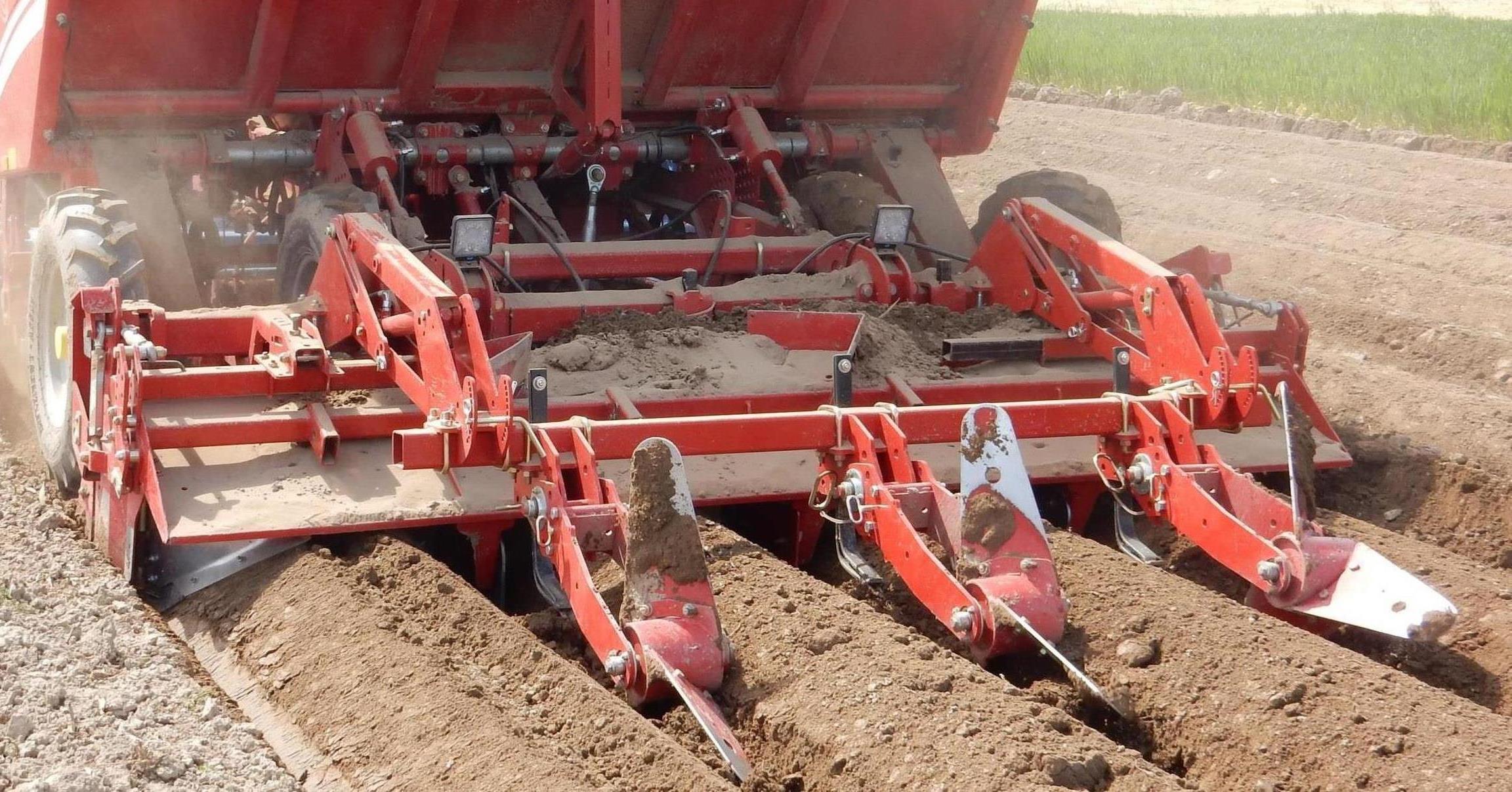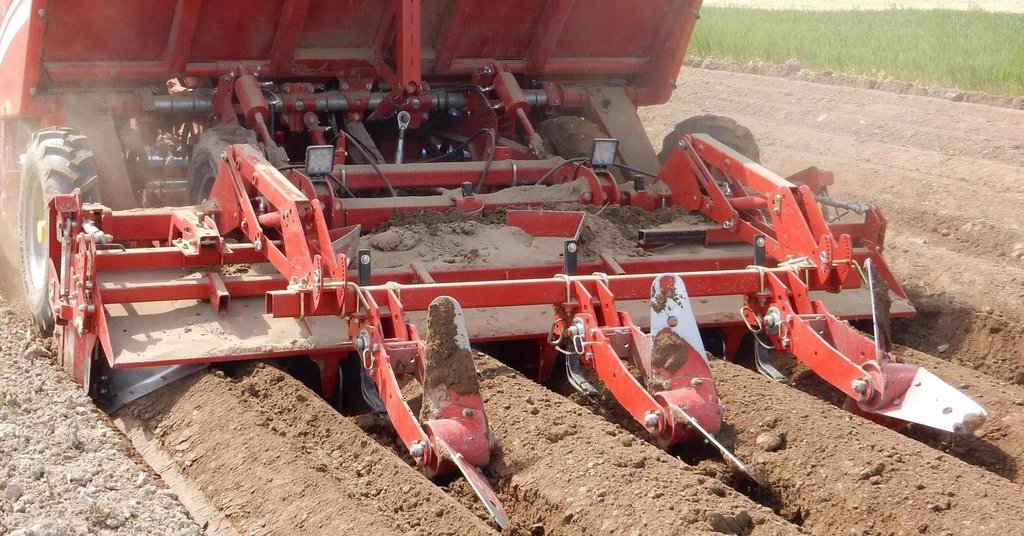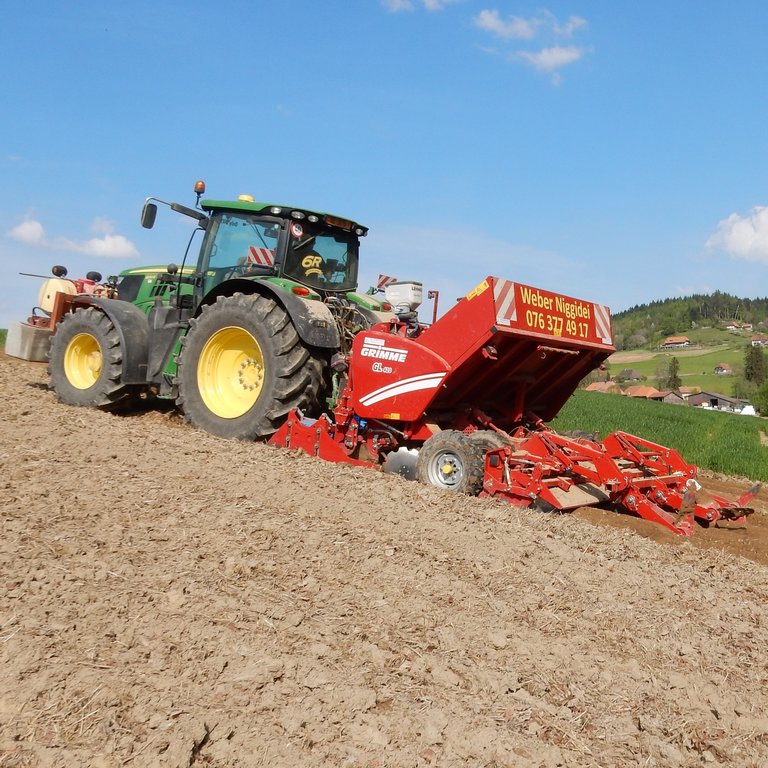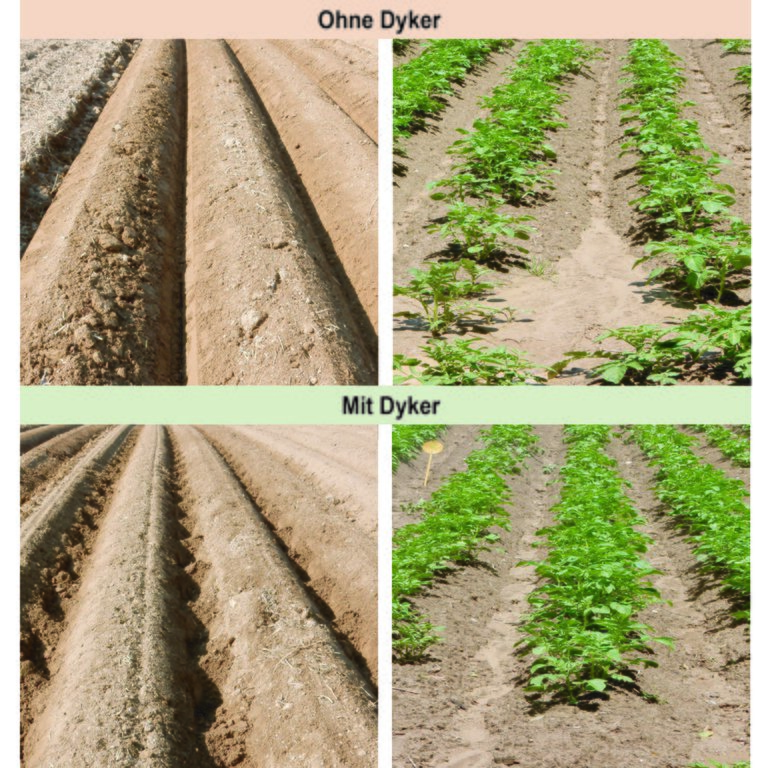Dyker-System (oder Lochstern) im Kartoffelanbau [Switzerland]
- Creation:
- Update:
- Compiler: Deborah Niggli
- Editor: –
- Reviewer: Tatenda Lemann
Dyker-System (oder Lochstern) im Kartoffelanbau
technologies_1296 - Switzerland
View sections
Expand all Collapse all1. General information
1.2 Contact details of resource persons and institutions involved in the assessment and documentation of the Technology
Name of project which facilitated the documentation/ evaluation of the Technology (if relevant)
Preventing and Remediating degradation of soils in Europe through Land Care (EU-RECARE )Name of the institution(s) which facilitated the documentation/ evaluation of the Technology (if relevant)
CDE Centre for Development and Environment (CDE Centre for Development and Environment) - Switzerland1.3 Conditions regarding the use of data documented through WOCAT
When were the data compiled (in the field)?
27/08/2015
The compiler and key resource person(s) accept the conditions regarding the use of data documented through WOCAT:
Yes
1.4 Declaration on sustainability of the described Technology
Is the Technology described here problematic with regard to land degradation, so that it cannot be declared a sustainable land management technology?
No
2. Description of the SLM Technology
2.1 Short description of the Technology
Definition of the Technology:
Hinter der Kartoffelsetzmaschine angehängt, gräbt der Dyker (Lochstern) mit seinen Schaufelrädern Löcher in die Sohle der Furchen zwischen den Kulturdämmen.
2.2 Detailed description of the Technology
Description:
Mit dem Dyker (Lochstern) ist ein neues Gerät für Landwirte zum Anbau von Kartoffeln verfügbar. Dieses ist erhältlich von der Firma Grimme aus Deutschland. Hinter der Kartoffelsetzmaschine angehängt, gräbt der Dyker (Lochstern) mit seinen Schaufelrädern Löcher in die Sohle der Furchen. Dabei dringt die Spitze der Schaufel in den Boden ein und wirft im Nachlauf diesen schräg ab. Die durch den Lochstern erzeugten Löcher sollen die Wasserinfiltration verbessern und dadurch das Wasser in den eigenen Reihen für die Kulturen zurückhalten, Stauwasser und Vernässung in den Senken verhindern und den Oberflächenabfluss und damit Erosion minimieren.
Der Dyker kann an eine "all-in-one" Kartoffellegmaschine angehängt werden und braucht keinen zusätzlichen Arbeitsgang. Wird der Dyker an einen Traktor gehängt, braucht es nach dem Pflanzen der Kartoffeln noch einen oder mehrere zusätzliche Arbeitsdurchgänge.
Das System beim Anbau von Kartoffeln Erosion und Staunässe verringern. Bei Dammkulturen kommt es wegen der oftmals parallel zum Hang liegenden Dämme zu Erosionsschäden während grösseren Niederschlagsereignissen - insbesondere in den ersten vier bis acht Wochen nach Ansaat, bis die Pflanzen wachsen und eine schützende Bodenbedeckung bilden. Die kleinen Löcher und Zwischendämme sollen den Abfluss bremsen und die Infiltration fördern. Damit sollen Erosion und Staunässe bei Dammkulturen verringert werden.
2.3 Photos of the Technology
2.4 Videos of the Technology
Comments, short description:
Der Lochstern im Einsatz hinter einem Kartoffelpflanzer GL 420 von Grimme.
Date:
07/05/2016
Location:
Frienisberg
Name of videographer:
Tatenda Lemann
2.5 Country/ region/ locations where the Technology has been applied and which are covered by this assessment
Country:
Switzerland
Region/ State/ Province:
Bern
Further specification of location:
Wiler bei Seedorf BE
Map
×2.6 Date of implementation
If precise year is not known, indicate approximate date:
- less than 10 years ago (recently)
2.7 Introduction of the Technology
- Durch innovativer Lohnunternehmer
3. Classification of the SLM Technology
3.1 Main purpose(s) of the Technology
- improve production
- reduce, prevent, restore land degradation
3.2 Current land use type(s) where the Technology is applied

Cropland
- Annual cropping
Comments:
Major land use problems (land users’ perception): Das Hauptproblem der Landnutzung ist klar die Erosionsgefährdung der Flächen an Hanglage. Während starken Niederschlägen (vor allem im Sommer) kommt es immer wieder zu Bodenverlusten infolge Erosion. Die Nutzung des Pfluges ist in dieser Region kein grosses Landnutzungsproblem mehr, da nur noch eine sehr geringe Anzahl an Bauern den Pflug nutzt. Viele Betriebe haben auf Direktsaat, Mulchsaat oder Streifenfrässaat umgestellt.
3.3 Further information about land use
Water supply for the land on which the Technology is applied:
- rainfed
Number of growing seasons per year:
- 1
3.4 SLM group to which the Technology belongs
- cross-slope measure
- water diversion and drainage
3.5 Spread of the Technology
Specify the spread of the Technology:
- evenly spread over an area
If the Technology is evenly spread over an area, indicate approximate area covered:
- < 0.1 km2 (10 ha)
3.6 SLM measures comprising the Technology

agronomic measures
- A3: Soil surface treatment
- A4: Subsurface treatment
3.7 Main types of land degradation addressed by the Technology

soil erosion by water
- Wt: loss of topsoil/ surface erosion
3.8 Prevention, reduction, or restoration of land degradation
Specify the goal of the Technology with regard to land degradation:
- prevent land degradation
4. Technical specifications, implementation activities, inputs, and costs
4.2 Technical specifications/ explanations of technical drawing
Technical knowledge required for field staff / advisors: moderate
Technical knowledge required for land users: high
Main technical functions:
-control of concentrated runoff: retain / trap,
-control of concentrated runoff: impede / retard,
-control of concentrated runoff: drain / divert
Secondary technical functions:
-reduction of slope length,
-increase of infiltration
4.3 General information regarding the calculation of inputs and costs
Specify how costs and inputs were calculated:
- per Technology unit
Specify unit:
Dyker (Lochstern)
other/ national currency (specify):
CHF
4.4 Establishment activities
| Activity | Type of measure | Timing | |
|---|---|---|---|
| 1. | Einsatz Dyker während Kartoffelanbau | Agronomic |
4.5 Costs and inputs needed for establishment
| Specify input | Unit | Quantity | Costs per Unit | Total costs per input | % of costs borne by land users | |
|---|---|---|---|---|---|---|
| Labour | Labour | Tage/Jahr | 2.0 | 250.0 | 500.0 | |
| Equipment | Dyker (Lochstern) | stk | 1.0 | 8500.0 | 8500.0 | |
| Total costs for establishment of the Technology | 9000.0 | |||||
If land user bore less than 100% of costs, indicate who covered the remaining costs:
Kommt darauf an, ob der Dyker von einem Lohnunternhemer oder direkt von einem Bauern gekauft wird.
Comments:
Kosten für Saatgut, Dünger, Herbizide und Pestizide, welche auch ohne Dyker anfallen, wurden in der Berechnung nicht berücksichtigt. Die Berechnung geht davon aus, dass der Dyker mit einer "all-in-one" Kartoffellegmaschine zum Einsatz kommt und dadurch kein zusätzlicher Bearbeitungsdurchgang notwendig ist.
Wenn der Dyker durch den Lohnunternehmer zum Einsatz kommt, entstehen für den Bauern keine zusätzlichen Kosten.
4.8 Most important factors affecting the costs
Describe the most determinate factors affecting the costs:
-Wenn der Dyker einer "all-in-one" Kartoffellegmaschine angehängt wird, ist kein zusätzlicher Bearbeitungsdurchgang notwendig. Wenn der Dyker jedoch einem Traktor angehängt wird, sind nach dem Pflanzen der Kartoffeln ein oder mehrere Bearbeitungsdurchgänge notwendig.
-Wenn der Dyker von einem Lohnunternehmer angeschafft wird, entstehen in den meisten Fällen für die Bauern die den Lohnunternehmer unter Vertrag nehmen keine zusätzliche kosten.
5. Natural and human environment
5.1 Climate
Annual rainfall
- < 250 mm
- 251-500 mm
- 501-750 mm
- 751-1,000 mm
- 1,001-1,500 mm
- 1,501-2,000 mm
- 2,001-3,000 mm
- 3,001-4,000 mm
- > 4,000 mm
Agro-climatic zone
- sub-humid
Thermal climate class: temperate
5.2 Topography
Slopes on average:
- flat (0-2%)
- gentle (3-5%)
- moderate (6-10%)
- rolling (11-15%)
- hilly (16-30%)
- steep (31-60%)
- very steep (>60%)
Landforms:
- plateau/plains
- ridges
- mountain slopes
- hill slopes
- footslopes
- valley floors
Altitudinal zone:
- 0-100 m a.s.l.
- 101-500 m a.s.l.
- 501-1,000 m a.s.l.
- 1,001-1,500 m a.s.l.
- 1,501-2,000 m a.s.l.
- 2,001-2,500 m a.s.l.
- 2,501-3,000 m a.s.l.
- 3,001-4,000 m a.s.l.
- > 4,000 m a.s.l.
Indicate if the Technology is specifically applied in:
- not relevant
5.3 Soils
Soil depth on average:
- very shallow (0-20 cm)
- shallow (21-50 cm)
- moderately deep (51-80 cm)
- deep (81-120 cm)
- very deep (> 120 cm)
Soil texture (topsoil):
- medium (loamy, silty)
Topsoil organic matter:
- medium (1-3%)
If available, attach full soil description or specify the available information, e.g. soil type, soil PH/ acidity, Cation Exchange Capacity, nitrogen, salinity etc.
Soil texture is medium (loam, sandiger Lehm)
Soil fertility is high
Soil drainage infiltration is medium
Soil water storage capacity is medium
5.4 Water availability and quality
Ground water table:
5-50 m
Availability of surface water:
good
Water quality (untreated):
good drinking water
Is water salinity a problem?
No
Is flooding of the area occurring?
No
5.5 Biodiversity
Species diversity:
- high
5.6 Characteristics of land users applying the Technology
Sedentary or nomadic:
- Sedentary
Market orientation of production system:
- commercial/ market
Off-farm income:
- 10-50% of all income
Relative level of wealth:
- rich
Individuals or groups:
- individual/ household
Level of mechanization:
- mechanized/ motorized
Gender:
- men
Age of land users:
- children
Indicate other relevant characteristics of the land users:
Land users applying the Technology are mainly Leaders / privileged
5.7 Average area of land owned or leased by land users applying the Technology
- < 0.5 ha
- 0.5-1 ha
- 1-2 ha
- 2-5 ha
- 5-15 ha
- 15-50 ha
- 50-100 ha
- 100-500 ha
- 500-1,000 ha
- 1,000-10,000 ha
- > 10,000 ha
Is this considered small-, medium- or large-scale (referring to local context)?
- medium-scale
5.8 Land ownership, land use rights, and water use rights
Land ownership:
- individual, titled
Land use rights:
- communal (organized)
- individual
Water use rights:
- individual
5.9 Access to services and infrastructure
health:
- poor
- moderate
- good
education:
- poor
- moderate
- good
technical assistance:
- poor
- moderate
- good
employment (e.g. off-farm):
- poor
- moderate
- good
markets:
- poor
- moderate
- good
energy:
- poor
- moderate
- good
roads and transport:
- poor
- moderate
- good
drinking water and sanitation:
- poor
- moderate
- good
financial services:
- poor
- moderate
- good
6. Impacts and concluding statements
6.1 On-site impacts the Technology has shown
Socio-economic impacts
Production
crop production
risk of production failure
Income and costs
workload
Comments/ specify:
Wenn gleichzeitig wie die Kartoffellegmaschine zum Einsatz kommt, kaum zusätzlicher Aufwand.
Ansonsten zusätzliche Arbeitsdurchgänge notwendig.
Socio-cultural impacts
SLM/ land degradation knowledge
conflict mitigation
Ecological impacts
Water cycle/ runoff
surface runoff
Soil
soil loss
Other ecological impacts
6.2 Off-site impacts the Technology has shown
downstream flooding
damage on neighbours' fields
6.3 Exposure and sensitivity of the Technology to gradual climate change and climate-related extremes/ disasters (as perceived by land users)
Gradual climate change
Gradual climate change
| Season | Type of climatic change/ extreme | How does the Technology cope with it? | |
|---|---|---|---|
| annual temperature | increase | well |
Climate-related extremes (disasters)
Meteorological disasters
| How does the Technology cope with it? | |
|---|---|
| local rainstorm | not known |
Hydrological disasters
| How does the Technology cope with it? | |
|---|---|
| general (river) flood | not well |
6.4 Cost-benefit analysis
How do the benefits compare with the establishment costs (from land users’ perspective)?
Short-term returns:
slightly positive
Long-term returns:
positive
How do the benefits compare with the maintenance/ recurrent costs (from land users' perspective)?
Short-term returns:
neutral/ balanced
Long-term returns:
slightly positive
6.5 Adoption of the Technology
- 10-50%
Of all those who have adopted the Technology, how many have did so spontaneously, i.e. without receiving any material incentives/ payments?
- 50-90%
Comments:
Comments on acceptance with external material support: positive Reaktionen von aussen, vor allem wenn Bauer auch andere Felder mit Maschine bestellt!
There is a moderate trend towards spontaneous adoption of the Technology
Comments on adoption trend: Es wäre sicherlich ein grosser Trend zur Adoption da, doch die Maschine ist zum Kauf noch nicht auf dem Markt verfügbar.
6.6 Adaptation
Has the Technology been modified recently to adapt to changing conditions?
No
6.7 Strengths/ advantages/ opportunities of the Technology
| Strengths/ advantages/ opportunities in the land user’s view |
|---|
|
Die Problemkultur Kartoffeln, welche für Erosion sehr anfällig ist, kann mit Hilfe des Dyker-Systems nachhaltig vor Erosion geschützt werden. Die Zwischendämme reduzieren den Oberflächenabfluss und verbessern die Infiltration. |
6.8 Weaknesses/ disadvantages/ risks of the Technology and ways of overcoming them
| Weaknesses/ disadvantages/ risks in the land user’s view | How can they be overcome? |
|---|---|
| Der Überhang beim Wenden der Maschine erfordert Geschick und Zeit und ist teilweise sehr mühsam. | Gutes fachliches Wissen im Umgang mit schweren Maschinen und der korrekten Wendung ist notwendig. |
| Der Dyker kostet US$ 8000 – 8500. Für einen Lohnunternehmer ist dieser Betrag verkraftbar, da mehr Aufträge ausgeführt werden können. Für einen einzelnen Bauern ist dieser Betrag aber hoch. | Gemeinsame Nutzung des Dykers, oder ein Subventionsgefäss |
7. References and links
7.1 Methods/ sources of information
- field visits, field surveys
- interviews with land users
7.3 Links to relevant information which is available online
Title/ description:
RECARE Project Dissemination Hub
URL:
http://www.recare-hub.eu/stakeholder-platforms/frienisberg-switzerland
Links and modules
Expand all Collapse allLinks
No links
Modules
No modules






